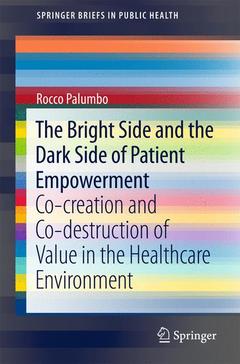The Bright Side and the Dark Side of Patient Empowerment, 1st ed. 2017 Co-creation and Co-destruction of Value in the Healthcare Environment SpringerBriefs in Public Health Series
Auteur : Palumbo Rocco

Patient empowerment as a key component in the future of healthcare systems is the focus of this concise in-depth analysis. It begins by defining patient empowerment as a collaborative partnership linking patients, providers, and systems, and examines the roles of health literacy, provider-patient and system-patient communication, and patient-centered care in the empowerment process. Models of positive and negative empowerment identify optimum conditions when patient and provider participate in service design and delivery as well as pitfalls and risks to patient and system when goals and input are mismatched. The book also translates concepts into practice with guidelines for empowerment strategies at the provider and organization levels to improve patient outcomes and system sustainability.
Included in the coverage:
· Empowering healthcare organizations to empower patients
· A re-design of the patient-provider partnership
· Patient empowerment: a requisite for sustainability · The risks of value co-destruction in service systems· The need for enlightening and managing the dark side of patient empowerment
· Disentangling the relationship between individual health literacy and patient empowerment
Straightforwardly written as a call for proactive change, The Bright Side and the Dark Side of Patient Empowerment is an illuminating text for scholars interested in patient empowerment and patient engagement, policymakers and managers operating in the healthcare field, and healthcare and social care providers.
Presents patient enablement as a requisite to patient empowerment
Rebalances healthcare provision through patient empowerment
Bridges the gap between the theory and practice of patient empowerment
Includes supplementary material: sn.pub/extras
Includes supplementary material: sn.pub/extras
Date de parution : 06-2017
Ouvrage de 84 p.
15.5x23.5 cm
Thèmes de The Bright Side and the Dark Side of Patient Empowerment :
Mots-clés :
patient empowerment initiatives; value co-creation in the healthcare environment; value co-destruction in the healthcare environment; patient involvement; patient enablement; healthcare management; healthcare service systems; patient-centered approach to care; healthcare reform; traditional biomedical/industrial model of health care; healthcare settings; healthcare administration; primary care; hospital care; patient participation; health system reforms; design and delivery of health services; provision of care; sustainable health care



